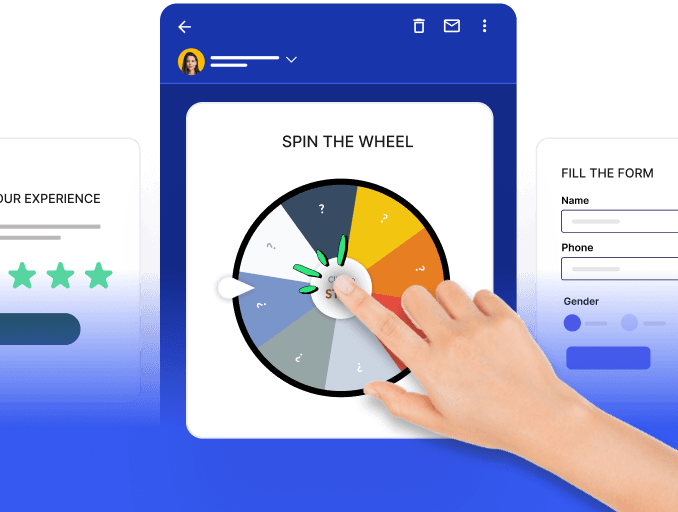When setting up a website popup, consider various factors like copy, design, and placement to maximize effectiveness. However, timing is crucial; even with the best design, improper timing can hinder the desired conversion rate.
Popup timing involves strategically presenting windows after a predetermined delay, unlike immediate popups. Timed popups focus on capturing attention at calculated intervals and at the right time. This approach, driven by the belief that timing is everything, aims to balance engagement and interruption.
This guide provides a comprehensive overview of popup timing, highlighting its vital role in preventing potential issues and explores 6 strategies to master the art of popup timing effectively.
Table of contents
What is a timed popup?
Timed popups are a distinct category of popups that emerge on a webpage after a user has spent a predefined time on the page as opposed to immediate popups or popups triggered by user behavior.
They serve as effective calls to action, appearing automatically after a set period, such as a few seconds or minutes, to engage visitors when they are likely to be the most receptive to the message or offer. This delay can be fine-tuned to align with users' average time on a page or customized to materialize during peak engagement moments.
Why is popup timing crucial?
Effective popup timing is crucial for optimizing engagement and conversion rates in any campaign. Premature popups can jeopardize the user experience, causing annoyance and dismissal. Conversely, strategic popup timing increases the likelihood of capturing user attention when they are receptive, ultimately boosting engagement and conversions. Striking the right balance is key, as too early or delayed popups can result in missed opportunities.
However, the consequences of bad popup timing are significant. Poorly timed popups disrupt the user experience, leading to higher abandonment rates and negatively impacting conversion rates. Some common problems associated with poorly timed popups include:
Immediate disruption: Popups that appear right after landing on a website can be disruptive and irritating, causing frustration and driving visitors away.
Inappropriate moments: Poorly timed popups can appear at inappropriate moments during the user journey, creating a negative impression and potentially deterring users.
Overlapping and clutter: Overlapping pop-ups or those appearing without delay can hide essential page content, creating a cluttered and overwhelming user experience.
Repeated irritation: Displaying the same popup repeatedly during a single visit or across multiple visits can irritate users and encourage them to leave the site.
Random disruption: Popups appearing at random or critical moments in the user's flow can disrupt their experience, causing frustration and annoyance.
Despite these challenges, it is possible to display pop-ups in a way that enhances the user's experience rather than disrupts it. By carefully considering the timing and relevance of popups, marketers can ensure that they contribute positively to the user's flow, ultimately maximizing conversion potential and campaign success.
Types of popups based on timing
You may need to use different pop-up types and timing strategies in different instances. Let’s explore some commonly used ones:
1. Time delay popups
This delay allows visitors to engage with the content and grasp your website's value before encountering an offer or call to action. Adjust the delay duration based on page type, user behavior, or audience characteristics.
You can implement a delay based on:
Time spent on your site in general.
Time spent on a specific web page.
2. Scroll-triggered popups
These are activated when a visitor scrolls beyond 50% of the webpage; these pop-ups strategically leverage user engagement through scrolling. By waiting for this interaction, marketers guarantee that the pop-up surfaces when visitors are interested in the content. This timing strategy aims to capture attention and engage visitors actively exploring the page, creating opportunities for further interaction.
3. Inactivity based popups
Inactivity popups are displayed when a visitor stays inactive on a page for a defined duration. This proves especially valuable for online stores, where an inactivity-based pop-up can remind visitors about items in their shopping cart or provide personalized recommendations based on their shopping preferences.
4. Exit intent popups
Exit intent popups are displayed when a visitor indicates intent to leave the website, such as moving the cursor towards the browser's close button. By detecting this behavior, exit intent pop-ups finally attempt to capture the visitor's attention, offering enticing incentives to encourage them to stay or subscribe to a newsletter.
5. Limited-time period popup
These popups are associated with specific, time-limited offers and are visible only when the offer is active. Though less specific than other approaches, they effectively draw attention to time-sensitive promotions, making them ideal for events, exclusive sales, competitions, challenges, and seasonal offers.
7. Behaviour based popups
Behavior based popups track user behavior such as visited pages, viewed products, or website actions, allows marketers to deliver targeted pop-ups at precise moments. For instance, presenting a discount or free consultation pop-up when users visit more than five pages in a single session capitalizes on their growing interest.
How to get popup timing right?
You can use several strategies to get the right time for your popups to be displayed.
1. Utilize average time metrics
You can determine the average engagement time of the users on your website and on each page by going to GA4 and following these steps.
Locate and click on "Reports" in the left-hand menu.
Navigate to "Engagement" and select "Overview."
Look for "Average engagement time" to find the overall engagement duration for your entire site.
To assess the time insights for each page,
Head to reports, navigate to engagement, and select pages and screens.
Here, you can see the engagement time for each page.
Your visitor’s average time data can help align your popup timing strategy:
For site-wide popups, utilize the average time on site, suitable for promotions like first-purchase discounts.
Adapt each popup according to the unique characteristics of the page it targets. Consider implementing a time delay slightly exceeding the average time on both the site and page—the optimal range being five to ten seconds.
Tailor page-specific popup timings using the average time on the page, ideal for targeted offers on specific content or products.
2. Integrate time delays with behavioral triggers
Behavioral triggers include clicking on a link, image, or button, scrolling a page, or exiting a page. Leveraging these triggers enables the creation of highly targeted popups, allowing valuable insights into a visitor's intent.
For instance, imagine a visitor about to exit your online store; using exit-intent technology is akin to extending a personalized lifeline. It allows you to present a tailored offer, like an exclusive time-sensitive discount for first-time buyers, adding a layer of precision beyond insights gathered solely from time spent on a page.
Most tools enable the convergence of time-based metrics and behavioral triggers. Simply create two or more triggers, apply the OR operator, and effortlessly integrate time on site, time on page, and user behaviors for a comprehensive popup strategy.
3. Adjust the timing based on the specific type of popup
Tailor your delay strategy to match the specific popup type for optimal effectiveness. While delaying popups is generally beneficial, it's crucial to consider the nature of each popup.
For instance, immediate fullscreen popups like "welcome mats" are designed to appear without delay at the start of a user session. For disruptive ones like modals, use longer delays coupled with triggers. Less intrusive options, such as slide-ins, benefit from shorter delays. These flexible guidelines can boost the effectiveness of each popup in your strategy.
4. Tailor your approach to the visitor’s purchase stage
It is important to consider the purchase stage of your visitors. With the highest visitor volume but lowest purchase intent, the top of the funnel benefits from a higher delay as it doesn’t disrupt the user experience. Consider reducing delays as you descend the funnel, where trust and brand familiarity are higher. Use the earlier guidelines to determine the appropriate risk levels for each segment; for instance, a 10-second delay above the average time on site for the top of the funnel and a five-second delay for bottom-of-the-funnel visitors.
5. Adapt to page content
Tailor popup timing by understanding each page's characteristics and goals. Analyze visitor time and engagement levels with analytics tools. Set time delays based on anticipated engagement, opting for longer delays for extensive content and shorter delays for brief interactions. Ensure seamless integration with the user experience to enhance content consumption. Integrate behavioral triggers like clicks or scrolls for a context-aware approach at pivotal content points.
6. Test and monitor
To optimize popup timing, start by employing testing with varied timing scenarios— before, during, and after average time on page or session duration—to identify the most effective strategy. Gather user feedback through surveys to understand preferences and tolerance levels, then analyze behavioral metrics, including bounce rates and conversions, to assess the impact of different timing approaches.
Ensure inclusivity by testing on mobile devices and customize popup timings based on factors like location, demographics, and user behavior. Utilize visual tools such as heatmaps and session recordings to gain insights into user interactions and assess the influence of popup timing on conversions. Continuously iterate your strategy based on test findings for optimal engagement and effectiveness.
Takeaways
The popup timing is very important as it helps elevate the user experience and conversion strategy. The power of perfect timing allows them to appear at just the right time user is most receptive. Throughout this guide, we have talked about how popup timing is crucial as it solves the problems that arise due to the wrong timing of the popups. The strategies mentioned above will help you get the popup timing right and contribute positively to your site’s visitor journey.







